fuse TOYOTA TACOMA 2020 Owners Manual (in English)
[x] Cancel search | Manufacturer: TOYOTA, Model Year: 2020, Model line: TACOMA, Model: TOYOTA TACOMA 2020Pages: 608, PDF Size: 11.6 MB
Page 5 of 608
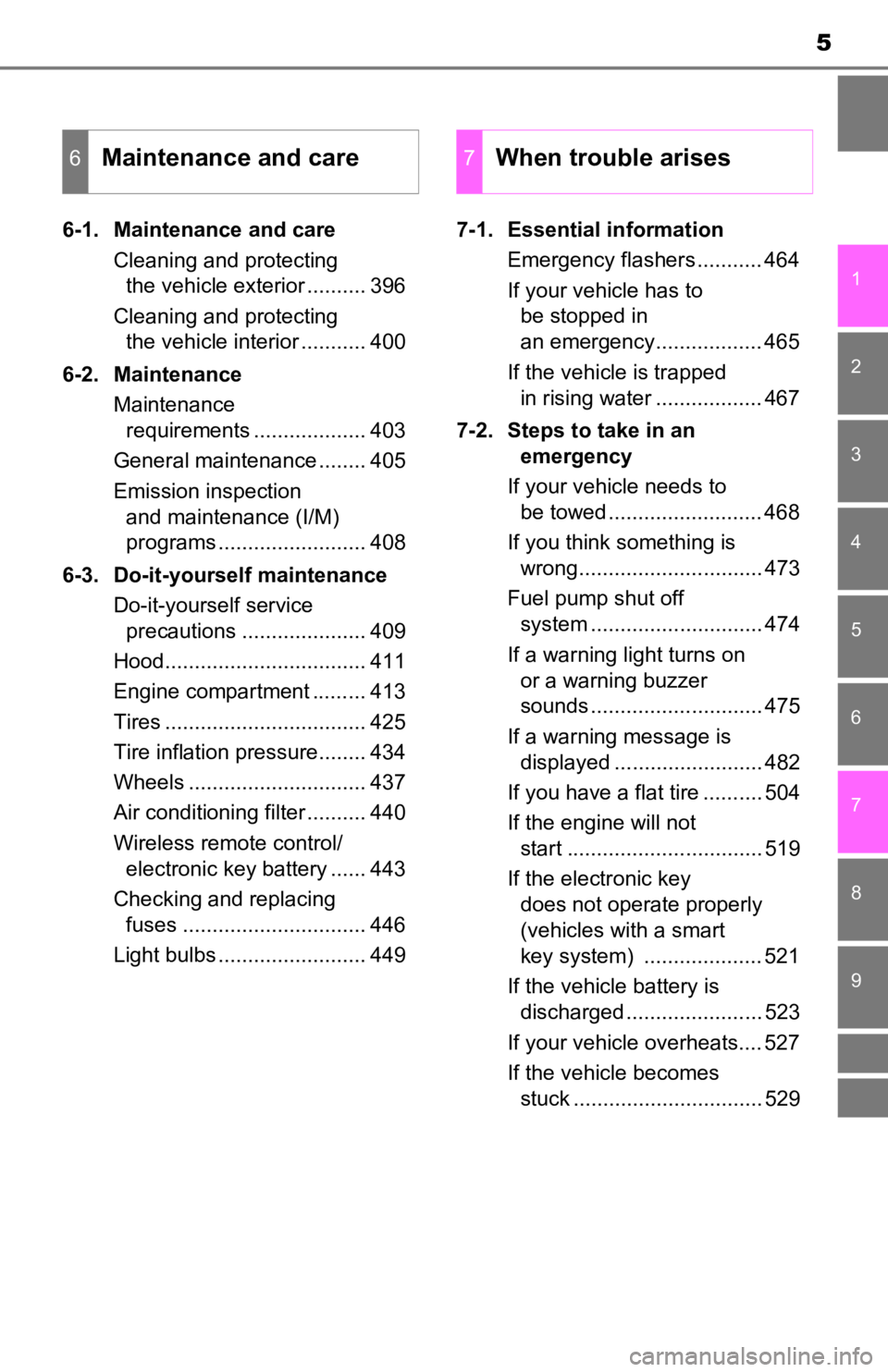
5
1
8 7 5 4
3
2
9
6
6-1. Maintenance and careCleaning and protecting the vehicle exterior .......... 396
Cleaning and protecting the vehicle interior ........... 400
6-2. Maintenance Maintenance requirements ................... 403
General maintenance ........ 405
Emission inspection and maintenance (I/M)
programs ......................... 408
6-3. Do-it-yourself maintenance Do-it-yourself service precautions ..................... 409
Hood.................................. 411
Engine compartment ......... 413
Tires .................................. 425
Tire inflation pressure........ 434
Wheels .............................. 437
Air conditioning filter .......... 440
Wireless remote control/ electronic key battery ...... 443
Checking and replacing fuses ............................... 446
Light bulbs ......................... 449 7-1. Essential information
Emergency flashers ........... 464
If your vehicle has to be stopped in
an emergency.................. 465
If the vehicle is trapped in rising water .................. 467
7-2. Steps to take in an emergency
If your vehicle needs to be towed .......................... 468
If you think something is wrong............................... 473
Fuel pump shut off system ............................. 474
If a warning light turns on or a warning buzzer
sounds ............................. 475
If a warning message is displayed ......................... 482
If you have a flat tire .......... 504
If the engine will not start ................................. 519
If the electronic key does not operate properly
(vehicles with a smart
key system) .................... 521
If the vehicle battery is discharged ....................... 523
If your vehicle overheats.... 527
If the vehicle becomes stuck ................................ 529
6Maintenance and care7When trouble arises
Page 374 of 608
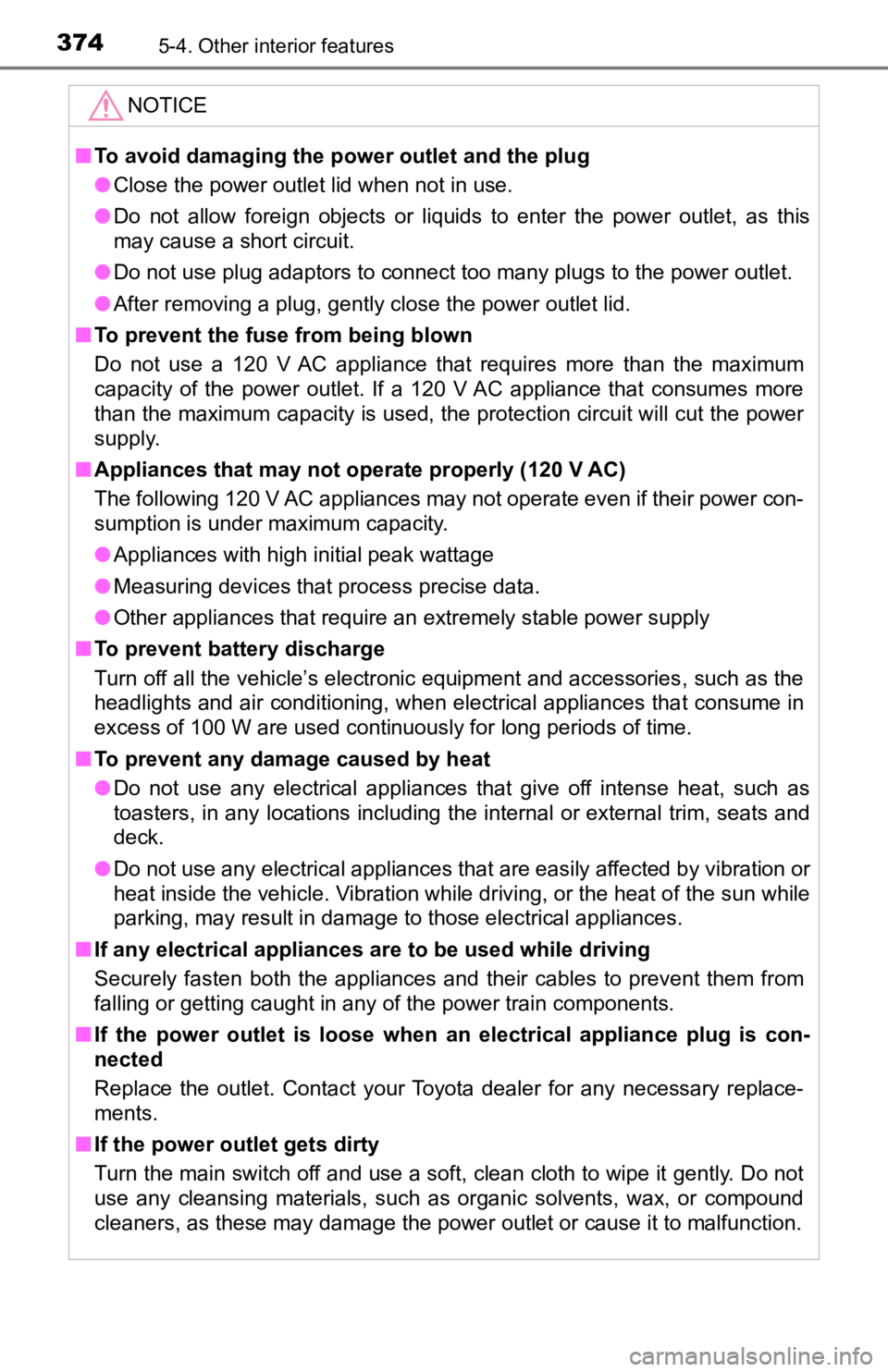
3745-4. Other interior features
NOTICE
■To avoid damaging the power outlet and the plug
● Close the power outlet lid when not in use.
● Do not allow foreign objects or liquids to enter the power outlet, as this
may cause a short circuit.
● Do not use plug adaptors to connect too many plugs to the power outlet.
● After removing a plug, gently close the power outlet lid.
■ To prevent the fuse from being blown
Do not use a 120 V AC appliance that requires more than the maximum
capacity of the power outlet. If a 120 V AC appliance that consumes more
than the maximum capacity is used, the protection circuit will cut the power
supply.
■ Appliances that may not op erate properly (120 V AC)
The following 120 V AC appliances may not operate even if their power con-
sumption is under maximum capacity.
● Appliances with high initial peak wattage
● Measuring devices that process precise data.
● Other appliances that require an extremely stable power supply
■ To prevent battery discharge
Turn off all the vehicle’s electronic equipment and accessories, such as the
headlights and air conditioning, when electrical appliances tha t consume in
excess of 100 W are used continuously for long periods of time.
■ To prevent any damage caused by heat
● Do not use any electrical appliances that give off intense heat, such as
toasters, in any locations including the internal or external t rim, seats and
deck.
● Do not use any electrical appliances that are easily affected by vibration or
heat inside the vehicle. Vibration while driving, or the heat o f the sun while
parking, may result in damage to those electrical appliances.
■ If any electrical appliances are to be used while driving
Securely fasten both the appliances and their cables to prevent them from
falling or getting caught in any of the power train components.
■ If the power outlet is loose when an electrical appliance plug is con-
nected
Replace the outlet. Contact your Toyota dealer for any necessary replace-
ments.
■ If the power outlet gets dirty
Turn the main switch off and use a soft, clean cloth to wipe it gently. Do not
use any cleansing materials, such as organic solvents, wax, or compound
cleaners, as these may damage the power outlet or cause it to m alfunction.
Page 395 of 608

395
6Maintenance and care
6-1. Maintenance and careCleaning and protecting the vehicle exterior .......... 396
Cleaning and protecting the vehicle interior ........... 400
6-2. Maintenance Maintenance requirements ................... 403
General maintenance ........ 405
Emission inspection and maintenance (I/M)
programs ......................... 408 6-3. Do-it-yourself maintenance
Do-it-yourself service precautions ..................... 409
Hood ................................. 411
Engine compartment ......... 413
Tires .................................. 425
Tire inflation pressure ....... 434
Wheels .............................. 437
Air conditioning filter.......... 440
Wireless remote control/ electronic key battery ...... 443
Checking and replacing fuses ............................... 446
Light bulbs......................... 449
Page 409 of 608
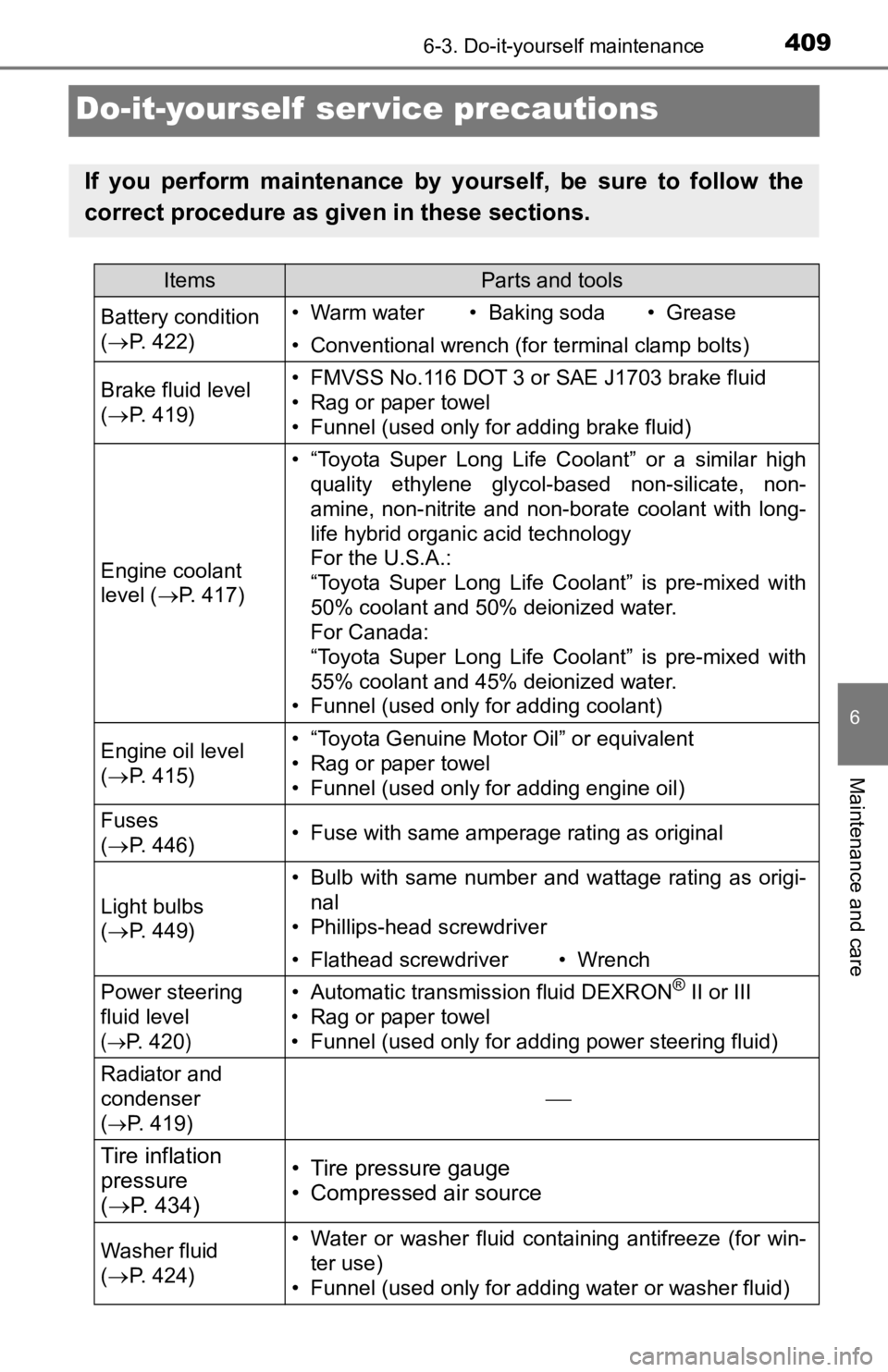
4096-3. Do-it-yourself maintenance
6
Maintenance and care
Do-it-yourself ser vice precautions
If you perform maintenance by yourself, be sure to follow the
correct procedure as given in these sections.
ItemsParts and tools
Battery condition
( P. 422)• Warm water• Baking soda• Grease
• Conventional wrench (for terminal clamp bolts)
Brake fluid level
( P. 419)• FMVSS No.116 DOT 3 or SAE J1703 brake fluid
• Rag or paper towel
• Funnel (used only for adding brake fluid)
Engine coolant
level ( P. 417)
• “Toyota Super Long Life Coolant” or a similar high
quality ethylene glycol-based non-silicate, non-
amine, non-nitrite and non-borate coolant with long-
life hybrid organic acid technology
For the U.S.A.:
“Toyota Super Long Life Coolant” is pre-mixed with
50% coolant and 50% deionized water.
For Canada:
“Toyota Super Long Life Coolant” is pre-mixed with
55% coolant and 45% deionized water.
• Funnel (used only for adding coolant)
Engine oil level
( P. 415)• “Toyota Genuine Motor Oil” or equivalent
• Rag or paper towel
• Funnel (used only for adding engine oil)
Fuses
( P. 446)• Fuse with same amperage rating as original
Light bulbs
( P. 449)
• Bulb with same number and wattage rating as origi-
nal
• Phillips-head screwdriver
• Flathead screwdriver• Wrench
Power steering
fluid level
(
P. 420)
• Automatic transmission fluid DEXRON® II or III
• Rag or paper towel
• Funnel (used only for adding power steering fluid)
Radiator and
condenser
(
P. 419)
Tire inflation
pressure
( P. 434)• Tire pressure gauge
• Compressed air source
Washer fluid
( P. 424)• Water or washer fluid containing antifreeze (for win-
ter use)
• Funnel (used only for adding water or washer fluid)
Page 413 of 608
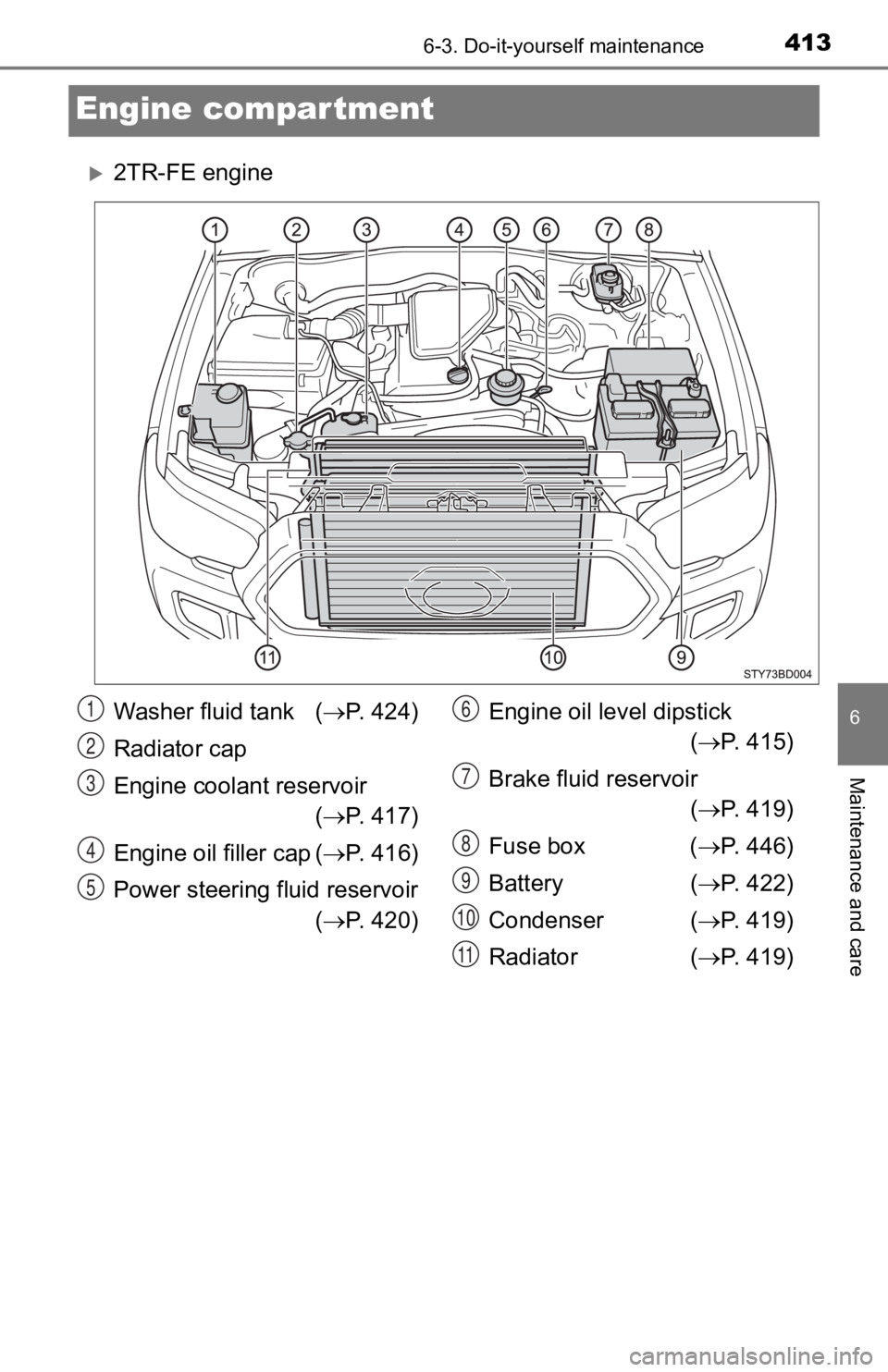
4136-3. Do-it-yourself maintenance
6
Maintenance and care
Engine compartment
2TR-FE engine
Washer fluid tank (P. 424)
Radiator cap
Engine coolant reservoir ( P. 417)
Engine oil filler cap ( P. 416)
Power steering fluid reservoir ( P. 420) Engine oil level dipstick
( P. 415)
Brake fluid reservoir ( P. 419)
Fuse box ( P. 446)
Battery ( P. 422)
Condenser ( P. 419)
Radiator ( P. 419)1
2
3
4
5
6
7
8
9
10
11
Page 414 of 608
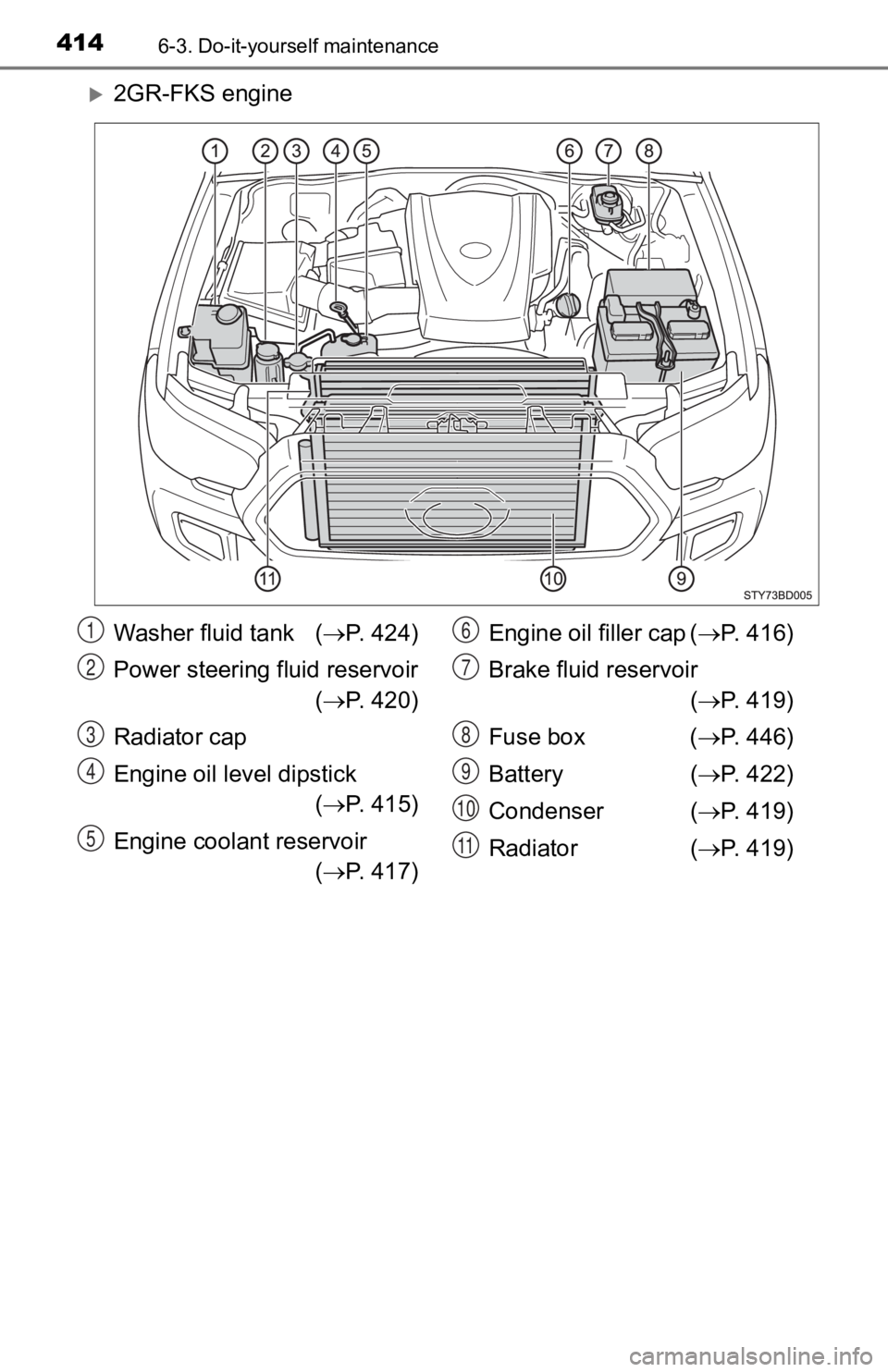
4146-3. Do-it-yourself maintenance
2GR-FKS engine
Washer fluid tank (P. 424)
Power steering fluid reservoir ( P. 420)
Radiator cap
Engine oil level dipstick ( P. 415)
Engine coolant reservoir ( P. 417) Engine oil filler cap (
P. 416)
Brake fluid reservoir ( P. 419)
Fuse box ( P. 446)
Battery ( P. 422)
Condenser ( P. 419)
Radiator ( P. 419)1
2
3
4
5
6
7
8
9
10
11
Page 446 of 608
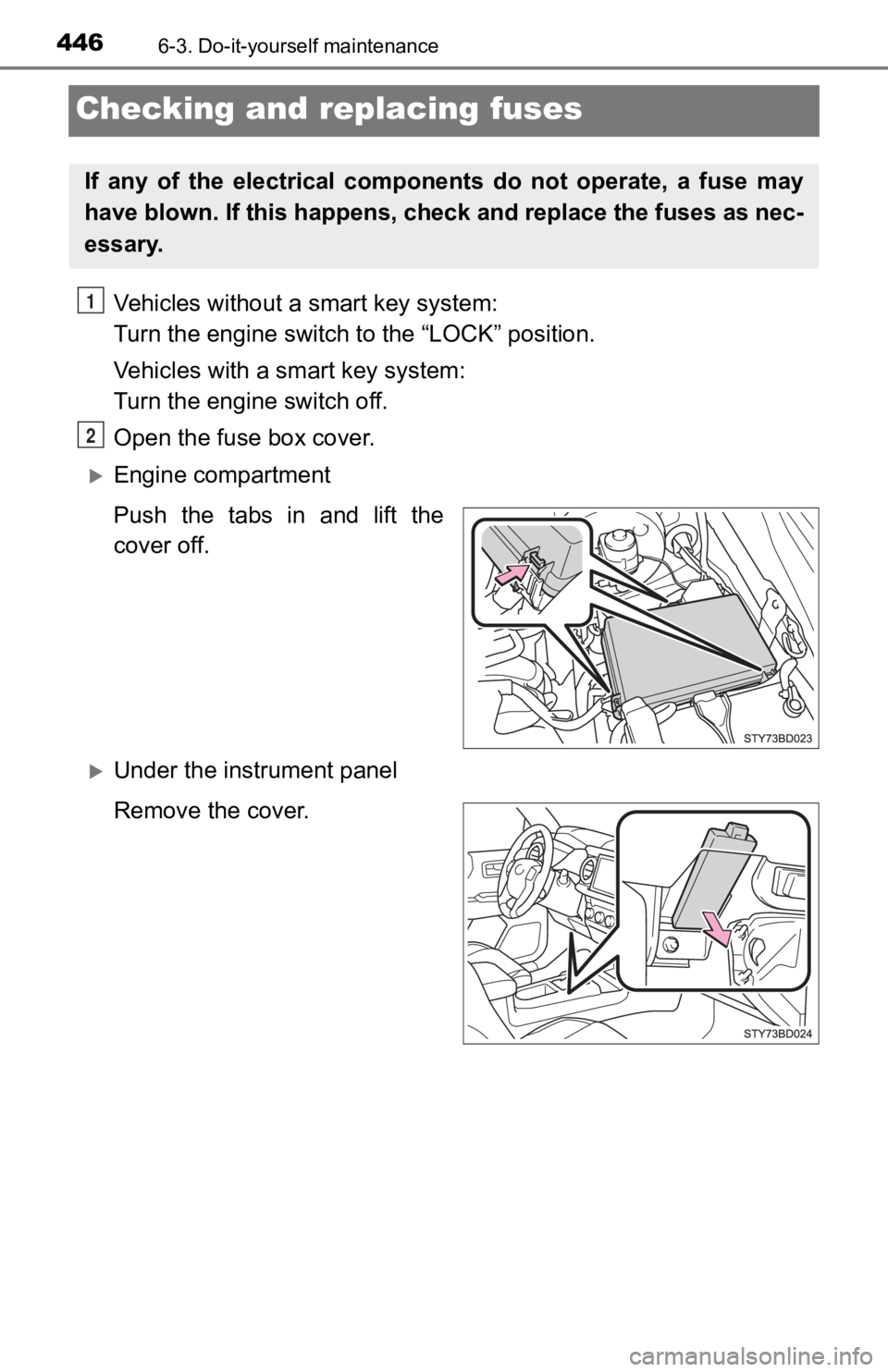
4466-3. Do-it-yourself maintenance
Checking and replacing fuses
Vehicles without a smart key system:
Turn the engine switch to the “LOCK” position.
Vehicles with a smart key system:
Turn the engine switch off.
Open the fuse box cover.
Engine compartment
Push the tabs in and lift the
cover off.
Under the instrument panel
Remove the cover.
If any of the electrical components do not operate, a fuse may
have blown. If this happens, check and replace the fuses as nec-
essary.
1
2
Page 447 of 608
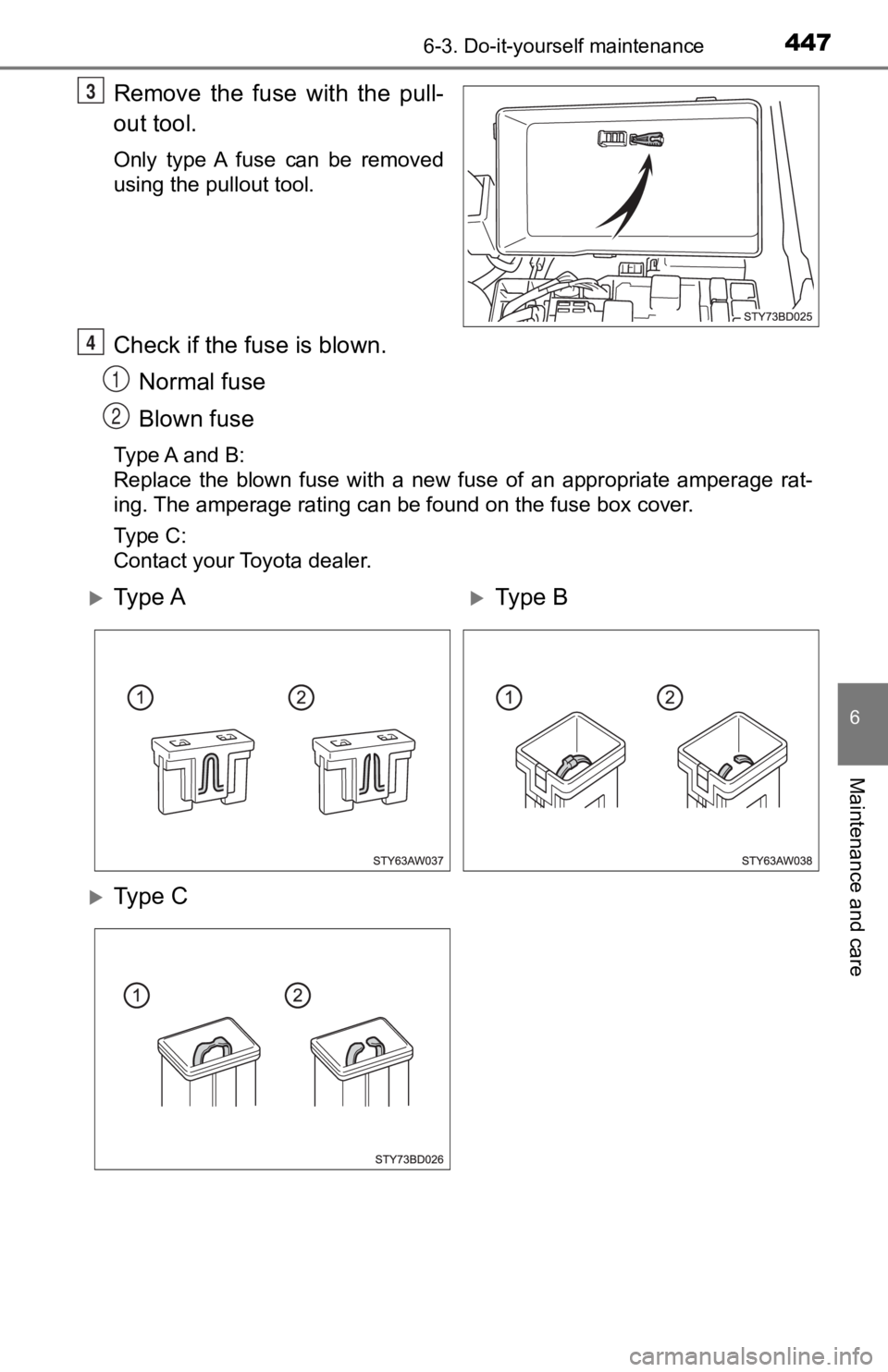
4476-3. Do-it-yourself maintenance
6
Maintenance and care
Remove the fuse with the pull-
out tool.
Only type A fuse can be removed
using the pullout tool.
Check if the fuse is blown.Normal fuse
Blown fuse
Type A and B:
Replace the blown fuse with a new fuse of an appropriate ampera ge rat-
ing. The amperage rating can be found on the fuse box cover.
Type C:
Contact your Toyota dealer.
3
4
1
2
Ty p e AType B
Ty p e C
Page 448 of 608
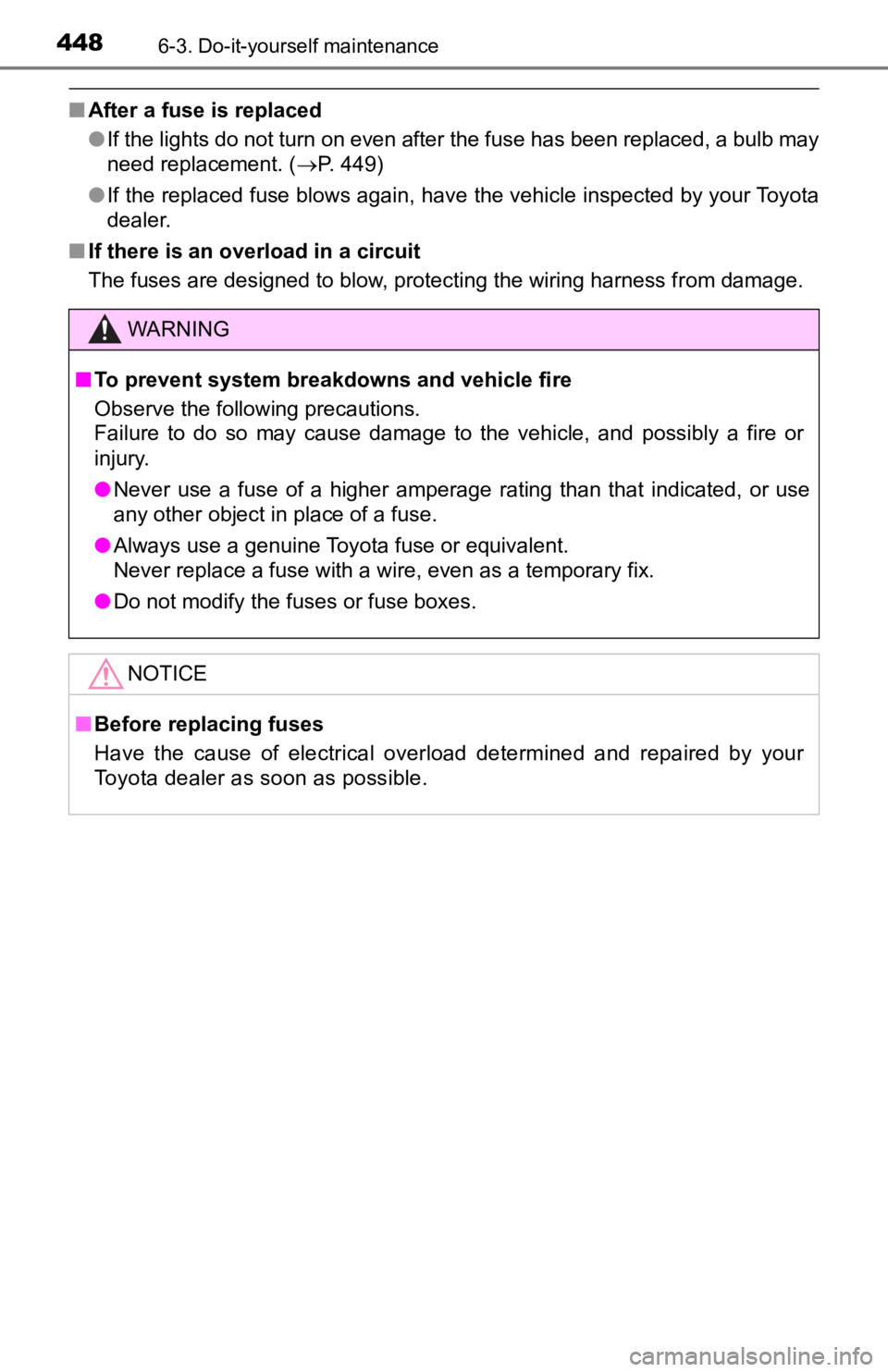
4486-3. Do-it-yourself maintenance
■After a fuse is replaced
●If the lights do not turn on even after the fuse has been repla ced, a bulb may
need replacement. ( P. 449)
● If the replaced fuse blows again, have the vehicle inspected by your Toyota
dealer.
■ If there is an overload in a circuit
The fuses are designed to blow, protecting the wiring harness from damage.
WARNING
■ To prevent system breakdowns and vehicle fire
Observe the following precautions.
Failure to do so may cause damage to the vehicle, and possibly a fire or
injury.
● Never use a fuse of a higher amperage rating than that indicate d, or use
any other object in place of a fuse.
● Always use a genuine Toyota fuse or equivalent.
Never replace a fuse with a wire, even as a temporary fix.
● Do not modify the fuses or fuse boxes.
NOTICE
■Before replacing fuses
Have the cause of electrical overload determined and repaired b y your
Toyota dealer as soon as possible.
Page 519 of 608
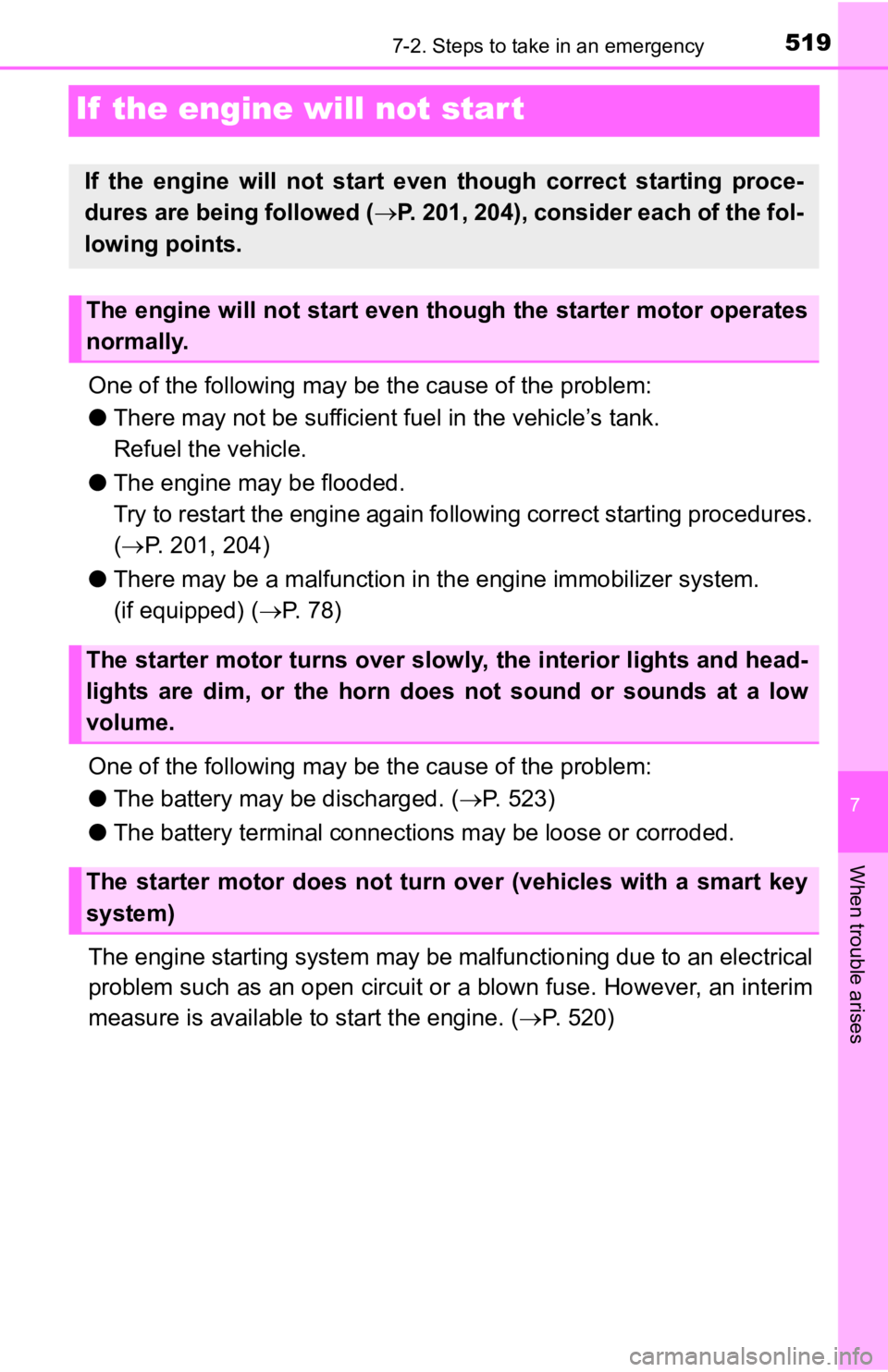
519
7
When trouble arises
7-2. Steps to take in an emergency
If the engine will not star t
One of the following may be the cause of the problem:
● There may not be sufficient f uel in the vehicle’s tank.
Refuel the vehicle.
● The engine may be flooded.
Try to restart the engine again following correct starting proc edures.
( P. 201, 204)
● There may be a malf unction in the engine immobilizer system.
(if equipped) ( P. 78)
One of the following may be the cause of the problem:
● The battery may be discharged. ( P. 523)
● The battery terminal connecti ons may be loose or corroded.
The engine starting system may be malfunctioning due to an elec trical
problem such as an open circuit or a blown fuse. However, an in terim
measure is available to start the engine. ( P. 520)
If the engine will not start eve n though correct starting proce -
dures are being followed ( P. 201, 204), consider each of the fol-
lowing points.
The engine will not start even t hough the starter motor operates
normally.
The starter motor turns over slowly, the interior lights and he ad-
lights are dim, or the horn does not sound or sounds at a low
volume.
The starter motor does not turn over (vehicles with a smart key
system)